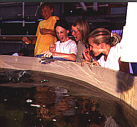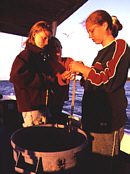 Pass the Old Bay, please...
Pass the Old Bay, please...
|
|
Fun facts to share with family and friends the
next time you sit down to a steaming table full of hard
crabs.
A crab-eat-crab
world
One of the biggest threats to young blue crabs might be
cannibalism. One study found that as many as 90 percent lose
their lives to their elders, and biologists believe a good
many do expire that way. The larger crabs prey on the young
ones and those that have molted and are soft.
Apron clues
Ever wonder, mallet poised, about the gender of the hard
crab you're about to dismantle? Check the "apron," found on
the crab's belly. Males have a T-shaped apron, while the
apron of the immature female is V-shaped; it becomes a "U"
in the mature female or "sook."
Two-for-one deal
For the female crab, sex seems to be a onetime affair. But a
female retains some of the male's sperm in order to spawn a
second time. (And boy, are they prolific, producing between
700,000 and 2 million crabs in a single spawning, though
only 1 percent of eggs reach adulthood.) Male crabs can
mate several times. And bigger crabs release more sperm.
Bigger by the molt
The lifespan of a crab is two or three years. With each
molt, or shedding of its shell, a crab gains about one-third
its size.
Salty cravings
Female crabs need to hatch their eggs in water with high
salinity, so expectant crabs in the Cheseapeake Bay region
head to the southern mouth of the bay; most male crabs are
content to remain in Maryland's northern bay waters. The
result: Virginia crabbers dredge up a disproportionate
number of female crabs, causing a fair amount of distress
among their Maryland counterparts, who complain about the
declining supply.
Source: State of Maryland
Illustration by Kevin O'Malley
|
|
Crabs pile up in the baskets: mostly No. 2s and some big ones:
No. 1s. One of the jimmies, or male crabs, is spewing bubbles.
Anne conveys some newfound knowledge: "He is trying to produce
more oxygen. The way crabs breathe, they suck water that moves
over their gills, and the gills take oxygen out of the water."
(Later, Anne will tell me with the same assurance that crabs can
live a day without their gills when they molt to grow a bigger
shell. They can't, but she sounds convincing.)
Murphy, meanwhile, passes along his version of a lesson or two,
mostly about the high--or low--politics of Maryland. He talks
about the abundance of people who put out industrial-style crab
pots, versus the baited trotlines he uses, as being the problem.
"This is a bad year; as long as the state of Maryland lets them
[crab potters] overharvest and overharvest, we are going to have
bad years. It's a damn shame."
Murphy keeps the boat on course with one finger on the wheel, and
measures the crabs with a carved wooden stick to check the
five-inch limit. The public's taste for crabs has created a
market even for small crabs, including immature females. Anne
asks him what's the biggest crab he's ever caught. "Not much
bigger than that one," he says pointing to a big jimmie. "How the
hell, if you catch all the babies, how can they get that big?" he
complains, as he pulls in several bushels of young crabs.
This afternoon they'll head out again on The Mildred Belle
to the Cooperative Oxford Laboratory run by the Maryland
Department of Natural Resources (DNR). As they wait, they gather
on a blue tarp, amid piles of sleeping bags and pillows. A few
weeks into the trip, the Blue Crabs are closer. Some of the
biology lessons are of another nature.
A scattered dialogue goes something like this. A question is
posed:
"What was the most interesting thing you learned about crabs?"
"Doubling," James Harris, who is entering the 8th grade, says of
the mating ritual.
"That's a 13-year-old boy talking," says fellow campgoer Becky
Cook.
James, 13, later says his great- grandfather is Marc Chagall (he
also told Bryan he went skydiving when he was 5 years old). There
is discussion about the benefits of Victoria's Secret catalogs
and tales about celebrities of a sort.
"The only famous person who ever graduated from my high school
was in Playboy magazine," Becky says. "How sad is
that?"
Becky, also 13, later says that when her parents were notified by
letter that she had gotten into the CAA program, they called the
school to see if it was a mistake. "Seriously," she says. She
says her father is Charles Cook, a political analyst who shows up
on Meet the Press. "Now he lets me go to speeches."
They seem to have something on their parents. The conversation
switches to how they can change the language on their moms' cell
phones into Spanish, Japanese, and Arabic.
These are children of a certain generation. Abby, the flower
child of the trip, says that her name used to be Stevie. When
she was 2 years old, she says, her parents changed her name to
Abby: "I guess they got over their obsession with Fleetwood Mac."
Her sister's middle name honors the song Rhiannon.
"If I have two boys, I'm going to name them Bob and Dylan," she
later says. "I have a friend named Joplin." After a while, such
sporadic conversation grows quiet, and a few nap, the summer sun
dappling bare arms.
On The Mildred Belle, the students, wearing faded yellow
life preservers, eat lunch: peanut butter and Marshmallow Fluff
sandwiches, potato chips, and cookies. As the boat pulls into a
dock at Oxford, out walks Keith Lockwood, a burly longtime surfer
wearing a white T-shirt, shorts, and sandals.
Lockwood, a DNR outreach specialist, gathers students around
several round tanks outside. He tells them how 16 million people
live in the Chesapeake Bay watershed. "They contribute to the
health and unhealth of the bay," he says.
Two of the bay's biggest problems, he says, are sediment and
fertilizer. Because of all the development in Maryland, more
sediment is running off and clouding the water, blocking sunlight
and coating the bottom. SAV's-- submerged aquatic vegetation--
cannot get the light needed to survive and produce dissolved
oxygen. Fertilizer and nutrients from animal waste also wash into
the bay, accelerating the growth of algae. The algae then crowd
out bay bottom plants and consume oxygen as they decompose each
fall.
The result in some areas: "A bay bottom that looks like that
parking lot out there," Lockwood says, pointing to the gravelly
surface nearby. "Grasses on the bay's bottom are an important
habitat. It's important for the blue crabs because it gives them
a place to hide."
Blue crabs are one of the few crabs that can swim, and the baby
crabs swim all the way up from the mouth of the Chesapeake Bay,
where the female crabs winter and hatch their eggs. "They don't
have much protection when the SAV beds are not there," Lockwood
says, noting the fish and other creatures who eat the tiny crabs.
"I like to say, it's like a plateful of chocolate chip cookies in
a house full of teenagers."
The teens giggle. Lockwood then tells them about the life cycle
of the blue crab, how the crabs are sometimes their own worst
enemy, gobbling up each other. He also conveys stories about the
terrapins, horseshoe crabs, trigger fish, puffer fish, and giant
40-pound striped bass in his tanks at the fisheries outreach
center and lab that's run jointly by DNR and the National Oceanic
and Atmospheric Administration (NOAA).
The lessons are many, and some harsh. At one point during the
lecture, Lockwood displays a doubler--a jimmie latched onto a
female crab, which is known as a peeler because she is about to
molt. Watermen like to catch these because they are a
two-for-one, and peelers are especially lucrative because they
will soon shed their shell and be marketed as soft-shell
crabs.
Lockwood tells the endearing tale of the crab mating ritual, in
which the male cradles the female for a few days: "How do they
find each other? She emits pheromones. It's like 'Hey baby, I'm
getting ready to shed my shell.'"
"He cradles her like that until she sheds," he says, showing two
crabs linked together on the bottom of a white bucket. "Then he
flips her over, impregnates her, flips her back over and cradles
her until her shell is hard. Then they basically go their own
way." Some crabs don't make it, because it's hard to breathe in
this position while molting, and crabs need a lot of oxygen to
live.
Later Lockwood pulls the two apart and holds the female up to the
light. He touches one of her flippers. "See the red tip?" he
asks. "This is a new flipper being formed. She'll shed within 24
hours."
He pauses and picks up a blue plastic trash can with holes in the
side and puts it in the tank where other crabs hang along the
bottom. He drops her inside the protective can. She sinks gently
into the water. "This jimmie can't protect her," he explains of
her mate, and points at the four other crabs in the tank.
"They'll kill her."
He looks down. "She'll shed tonight, and I'll have soft shell
crab for lunch tomorrow." Kids who had been leaning against the
tank snap their heads up. A few "Ohs?!" go up.
"Hey, I haven't had a softshell crab sandwich in a long time," he
says. "I'm part of the food chain, too."
The game is called Survival--the summer's ultimate lesson and, in
the end, the essence of all they've learned.
To play, the teens need to find hidden cards that read "dissolved
oxygen (D.O.)" and "habitat," and make a few kills to survive,
depending on their position on the food chain.
The players are divided into groups: bio-basic plankton;
secondary consumers such as crabs; or higher life forms,
represented by sharks and humans.
As the game begins, the plankton fan out into a field on Tilghman
Island, looking for D.O. cards in the grass and hiding from
predators. Five minutes later blue crabs, horseshoe crabs, and
Banded Killifish are given the signal to spread out and find the
means to live.
The sharks and the humans, meanwhile, start making deals. "I'll
lead the plankton to you guys, but then you can't kill me," says
Becky. "Let's gang up on Matt," a female voice says. That's Matt
Miller, a blond-haired shark some of the girls have a crush
on.
For the next half hour, the teens run around the lawn--dodging,
chasing, hiding and hunting, playing a game of evolutionary tag
as the sun goes down in a violet bath over the Chesapeake Bay.
RETURN TO
NOVEMBER 1999 TABLE OF CONTENTS.
|



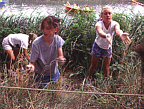
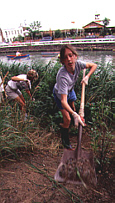
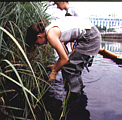
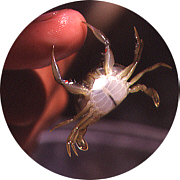 In the laboratory of Living Classrooms' Weinberg Education
Center, the Blue Crabs sit on gray-flecked white linoleum,
listening to a lesson about plankton. A few days before, they
conducted various lab experiments: studying crab behavior in
tanks when food is introduced, and learning how crabs
osmoregulate--which involves using their gills and other means to
control the amount of salt in their bodies so they can live in
waters with a wide range of salinity.
In the laboratory of Living Classrooms' Weinberg Education
Center, the Blue Crabs sit on gray-flecked white linoleum,
listening to a lesson about plankton. A few days before, they
conducted various lab experiments: studying crab behavior in
tanks when food is introduced, and learning how crabs
osmoregulate--which involves using their gills and other means to
control the amount of salt in their bodies so they can live in
waters with a wide range of salinity.